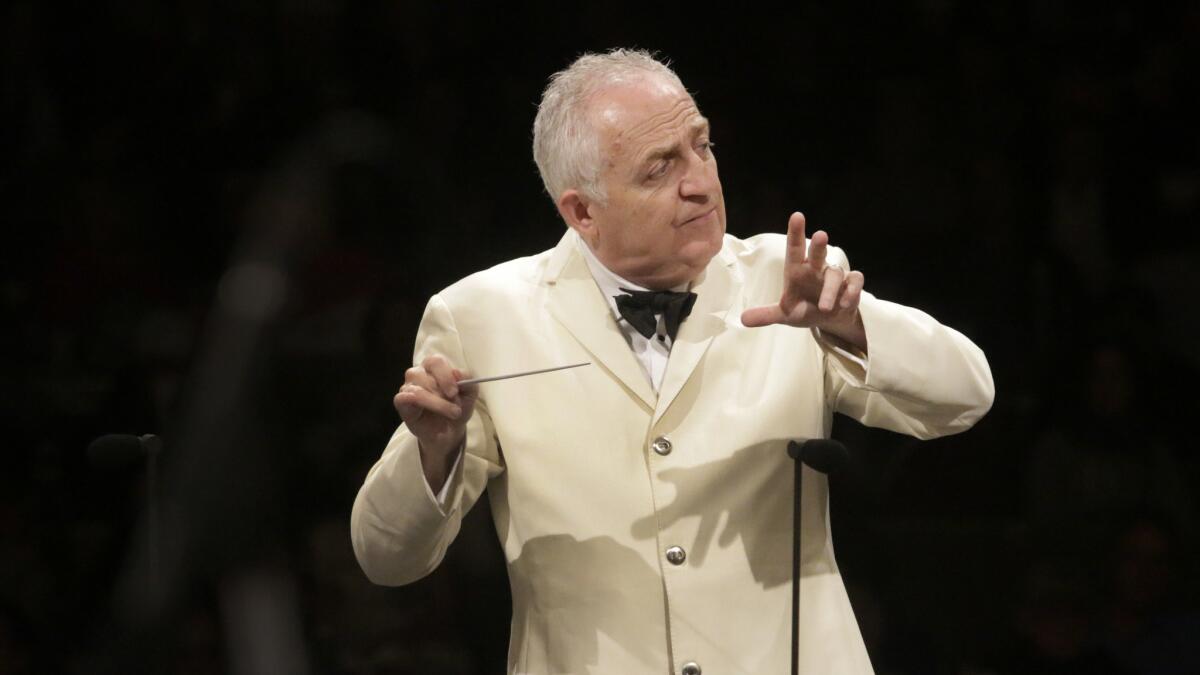Review: Sprightly Rachmaninoff maintains a run of Russians at the Bowl

Bramwell Tovey conducts the LA Phil at the Hollywood Bowl. The program was top-heavy with the formidable Rachmaninoff Piano Concerto No. 3 — now popularly known, thanks to the movie “Shine,” as the Rach 3 — leading off matters.
- Share via
Whether by design or not, the Hollywood Bowl is being overrun with Russian music this month.
On Tuesday night, the Los Angeles Philharmonic checked in with an all-Rachmaninoff program led by that perennial Bowl guest conductor, the irrepressible Bramwell Tovey. Last week, the Phil opened its summer season with a Russian first half and then went all-Russian with Tchaikovsky and Prokofiev two days later. Next week concludes with the indestructible Tchaikovsky Spectacular.
There’s nothing political or commemorative about this as far as I can tell, but if you are looking for a distinct pattern across the checkerboard of July concert programs, there it is.
Tuesday’s program was top-heavy with the formidable Rachmaninoff Piano Concerto No. 3 — now popularly known, thanks to the movie “Shine,” as the Rach 3 — leading off matters. But it wasn’t a heavy, barnstorming, super-virtuoso Rach 3 performance, for the veteran American pianist Garrick Ohlsson had other, more musical ideas in mind.
Ohlsson’s was a performance in cooperation with the orchestra, as opposed to dominating the orchestra, by turns clear-cut, delicate, articulate, highly rhythmic, lyrical yet schmaltz-free, perhaps drawing on a different Russian tradition, that of Stravinsky and Prokofiev.
At one point after Ohlsson turned a particularly witty phrase, the video screen caught him winking at the conductor.
Oh, yes, Ohlsson could turn on those big octaves at will when needed, and there were plenty of loud pianistic fireworks at the end.
But the payoff was made even more satisfying by the patient, methodical buildup to that moment.
The Symphonic Dances — Rachmaninoff’s last work — doesn’t come readily to mind on a short list of the composer’s most popular works, but maybe it should; a glance at the catalog indicates that it is right up there with the Second Symphony in its number of recordings (in orchestral and two-piano versions). In any case, it marked something new for Rachmaninoff, leaving gushing Romanticisms behind for leaner, sprightlier, imaginatively orchestrated textures.
Tovey caught this spirit with tough vigor in the first movement and a lighter, balletic touch in the second, digging into the mysterious corners of the third. Most tellingly, he maintained strong rhythms throughout, which had the effect of making the entire piece flow into a coherent whole.
As a prelude to the Symphonic Dances, the wistful Vocalise — which Tovey kept moving along — served as a signpost of the earlier, lusher Rachmaninoff manner.
More to Read
The biggest entertainment stories
Get our big stories about Hollywood, film, television, music, arts, culture and more right in your inbox as soon as they publish.
You may occasionally receive promotional content from the Los Angeles Times.









